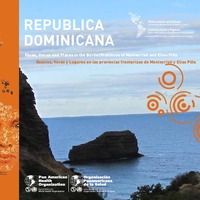Faces, Voices and Places in the border provinces of Montecristi and Elias Piña. Dominican Republic
Date
2011Metadata
Show full item recordAbstract
The Dominican Republic currently has a population of just over 10 million inhabitants. In a downward trend, its annual growth rate dropped from 1.8 in 2005 to 1.36 in 2010, and is currently estimated at 1.33. The population is predominantly young. Urban development has proceeded at a rapid pace: 65.1% of the total population lived in urban areas in 2008, compared to 30.3% in 1960. The country is facing an immigration situation in which 73% of migrants come from its neighbor, Haiti. In 2005, this percentage was equivalent to 873,000 people. Comprised mainly of young adult men, this population group places demands on health services, overloading the networks in municipalities where they concentrate for employment reasons (construction, the hotel industry). This includes border municipalities and other areas featuring pronounced economic development and tourism. According to the second report on the achievement of the Millennium Development Goals in the Dominican Republic, the population has grown 35% since the beginning of the 1990s— the reference period used in setting the MDGs—from 7.2 million in 1990 to 9.7 million in 2009. The Gross Domestic Product (GDP) grew 178% and the GDP per capita multiplied by 3.5. The Dominican Republic has had one of the best-performing economies in the Latin American and Caribbean region in terms of GDP growth over the past 20 years: with an average annual growth rate of 5.8%, the country reported its lowest rates in 2003 (-0.3%) and 2004 (1.3%), a result of the harsh toll taken by the domestic financial crisis. The pace of growth slowed in 2008 and 2009 in the context of the global economic crisis, dropping to a rate of 3.5 in 2009, which is much lower than the aforementioned averages. Even so, the growth rate of the Dominican economy remains significantly higher than the average for all Latin American and Caribbean countries. Despite high growth rates, a large percentage of the population continues to live in poverty. The country is lagging significantly behind in education, health, employment, and other human development indicators, an indication of the pressing need to remove economic, social and institutional restrictions that preclude a more effective use of resources, increased social investment, and better quality spending, and ultimately impede progress toward the MDGs.
Translated title
Rostros, Voces y Lugares en las Provincias Fronterizas de Montecristi y Elias Piña. Repúbilca Dominicana
Subject
Collections
Related items
Showing items related by title, author, creator and subject.
-
Pan American Health Organization (Pan American Health OrganizationUnited StatesWashington D.C, 2002)Over the period 1980-2000, the number of people living in poverty in Latin America and the Caribbean increased by 85 million to almost 220 million people. Close to 16% lives on less than a dollar a day, an increase of ...
-
Aith, Fernando; Castilla Martínez, Midalys; Cho, Malhi; Dussault, Gilles; Harris, Matthew; Padilla, Mónica; Tomblin Murphy, Gail; Tomlin, Paul; Valderas, José M. (2020)[Extract]. In 2015, the United Nations issued the Agenda for Sustainable Development Goals, which highlighted the need to ensure healthy lives and promote well-being for all across the lifespan. Goal 3 aims to make sure ...
-
Organización Panamericana de la Salud (OPSWashington, D.C., 2012)Presenta la última información disponible sobre los indicadores de salud de los países y territorios de la Región de las Américas. En ésta edición se destaca la mortalidad por las Causas Externas (CE), aquellas causas ...




